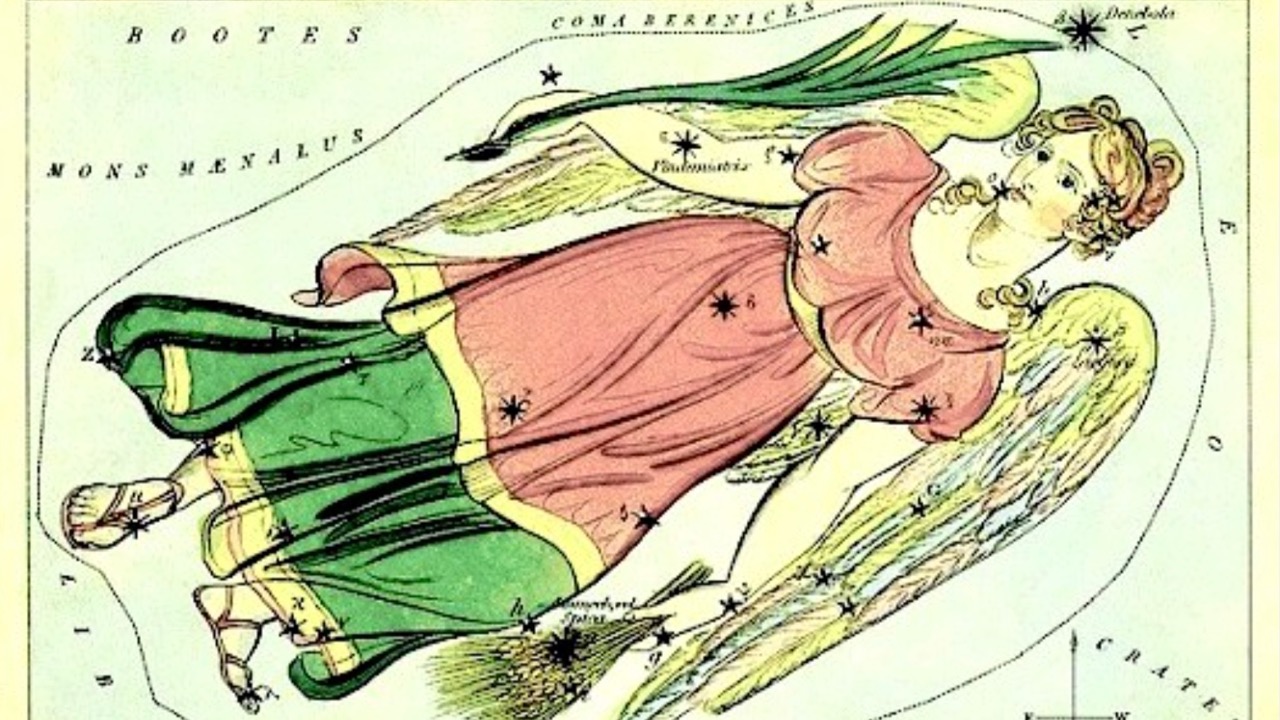

Classical illustration of the constellation Virgo the Maiden, via constellationsofwords.com.
The constellation Virgo the Maiden fully returns to sky at nightfall – with her feet planted on the eastern horizon – by late April and early May. Virgo appears in the evening sky on late May, June and July evenings, too. Then by late August or September, Virgo begins her descent into the glow of evening twilight.
How to find the constellation Virgo. It’s easy to see why early stargazers named this pattern of stars for the goddess of the harvest.
Virgo ranks as the largest constellation of the zodiac and the second-largest constellation overall (after Hydra). Yet Virgo’s long and rambling group of stars doesn’t lend itself to a well-defined pattern. It’s very difficult for most people to make out the winged maiden holding an ear of wheat in her left hand.
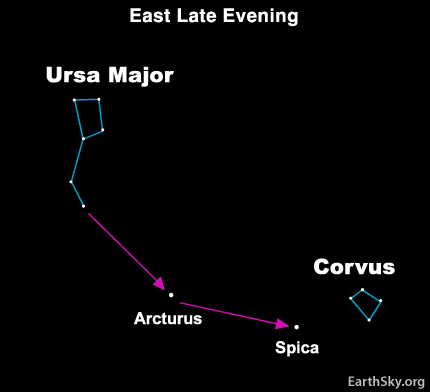
You can always follow the curve in the handle of the Big Dipper to the bright orange star Arcturus, then extend that line to Spica, Virgo’s brightest star.
Fortunately, Virgo’s first-magnitude star, sparkling blue-white Spica, makes this constellation fairly easy to locate in the night sky. If you live in the Northern Hemisphere, and are familiar with the Big Dipper asterism, you can star-hop to this gem of a star from the handle of the Big Dipper. Moreover, since the Big Dipper is quite high in the sky on May and June evenings, even people at tropical and subtropical regions in the Southern Hemisphere can use the Big Dipper at this time of year to locate Spica, Virgo’s brightest star.
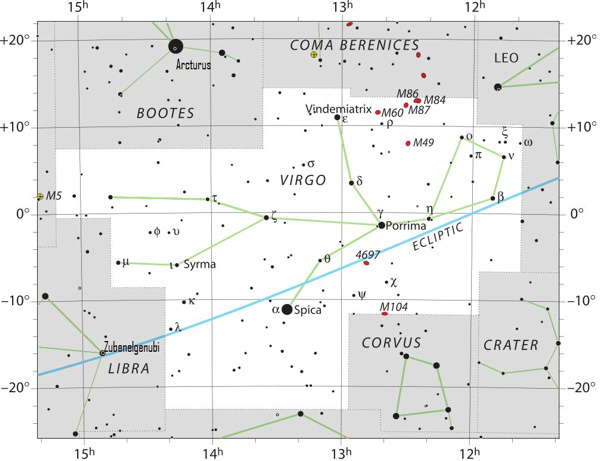
View larger. | The constellation Virgo. Image via Wikipedia.
The mnemonic goes like this: arc to Arcturus and spike Spica. In other words, follow the arc in the handle of the Big Dipper until you see an orange star. That is Arcturus in the constellation Boötes. Then continue that line to Spica.
So if the easy-to-recognize Big Dipper is visible in your sky, use it to star-hop to Spica, Virgo’s brightest star. You can be sure you’ve found Spica if you notice a lopsided square pattern nearby. That little pattern is another constellation, Corvus the Crow.
Spica climbs highest for the night – as seen from both the Northern and the Southern Hemispheres – at roughly local midnight (1 a.m. daylight saving time) in middle April. Because the stars return to the same place in the sky about two hours earlier with each passing month, look for Spica to be highest up at mid-May around 10 p.m. (11 p.m. daylight saving time), and at mid-June at about 8 p.m. (9 p.m. daylight saving time). These times refer to your local time.
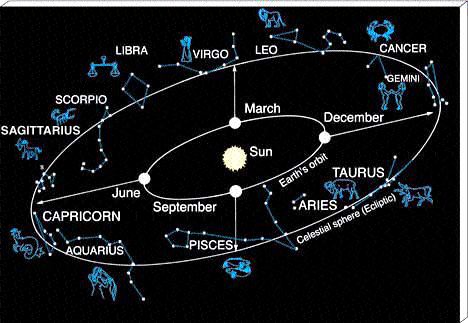
We are surrounded by stars. Because Earth orbits in a flat plane around the sun, we see the sun against the same stars again and again throughout the year. Those constellations, which have been special to people throughout the ages, are the constellations of the Zodiac. Image via Professor Marcia Rieke.
Sun in front of Virgo on your birthday? The sun passes in front of the constellation Virgo each year from about September 16 to October 30. Because Virgo is such a large constellation, the sun stays in front of Virgo for longer than one month.
Dates of sun’s entry into each constellation of the zodiac
The dates of the sun’s passage through Virgo may conflict with what you read on the horoscope page, which probably says from about August 23 to September 22. Keep in mind that astrologers are referring to the sign – not the constellation – Virgo. Yes, there is a difference between a constellation and a sign!
A constellation of the zodiac refers to certain section of the starry sky. On the other hand, a sign of the zodiac refers to the seasonal position of the sun, irrespective of what constellation backdrops the sun at a given season.
For instance, the March equinox marks the first point of (the sign) Aries, the June solstice marks the first point of (the sign) Cancer, the September equinox marks the first point of (the sign) Libra, and the December solstice marks the first point of (the sign) Capricorn.
By definition, the first point of (the sign) Libra always coincides with the sun’s position on the September equinox. This is in spite of the fact that the sun shines in front of the constellation Virgo on the September equinox nowadays. The sun resides in the sign Libra for one month, starting on or near September 23, yet the sun also shines in front of the constellation Virgo during this period of time.
Constellations are less abstract than signs, so astronomers and stargazers who directly observe the night sky find it easier to refer to constellations. It’s not incorrect to list the star Spica’s position as Libra 23o 50’ but that bit of information won’t help many people to locate Spica, the constellation Virgo’s brightest star.
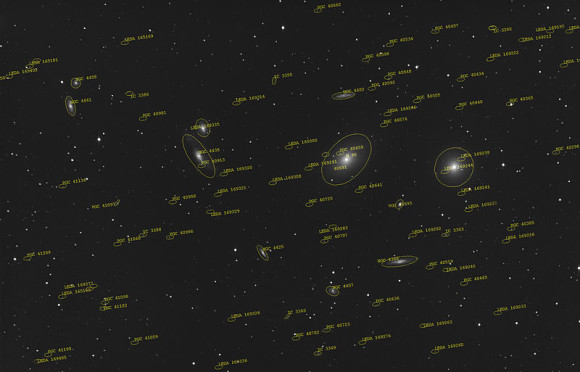
The Virgo galaxy cluster, via Wikimedia Commons.

The famous Sombrero Galaxy (M104) is thought by some to belong to the Virgo cluster. Image via mini82.
Virgo galaxy cluster. In mythology, Virgo represents fruitfulness and fertility, but this wondrous constellation has also proven its fruitfulness in ways undreamed of by the ancients. This constellation is the home of the great Virgo galaxy cluster, a conglomeration made up of thousands of galaxies. A few of these galaxies are actually visible as faint smudges of light through a small telescope. That in itself is pretty amazing, given that the Virgo cluster of galaxies lies some 65 million light-years distant.
Perhaps the most famous galaxy residing within Virgo’s borders is the Sombrero galaxy (M104). There seems to be disagreement, though, on whether this galaxy is a member of the Virgo galaxy cluster.
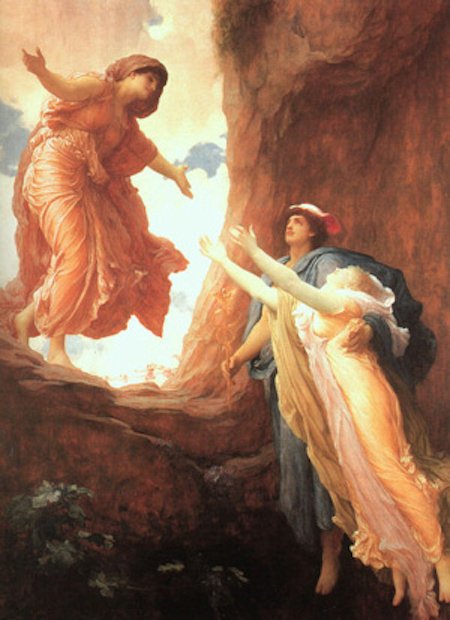
The Return of Persephone by Frederic Leighton. Image via Wikipedia.
Virgo in ancient mythology. The constellation Virgo is often said to personify Persephone, the daughter of Demeter, the harvest goddess. According to the famous Greek myth, eternal spring once reigned upon the Earth, until that fateful day when the god of the underworld abducted Persephone, the radiant maiden of spring.
Her mother Demeter was so overcome with grief over the loss of her only child that she abandoned her role as the goddess of fruitfulness and fertility. In some parts of the globe, the winter cold turned the once-verdant Earth in to a frigid wasteland, while elsewhere the summer heat scorched the Earth and gave rise to pestilence and disease. The Earth would not bear fruit again until Demeter was reunited with her daughter.
Humanity would have died altogether had not Zeus, the king of the gods, intervened. Zeus insisted that the god of the underworld return Persephone back to Demeter, but also proclaimed that Persephone abstain from food until her return. Alas, the god of the underworld purposely gave Persephone a pomegranate, knowing she would suck on a pomegranate seed on her way home.
Persephone was given back to her mother, but Persephone – because of the pomegranate – has to return to the underworld for four months every year. To this day, spring returns to the Northern Hemisphere when Persephone is reunited with Demeter, but the winter season reigns when Persephone dwells in the underworld.
That’s why, according to myth, it’s spring when the constellation Virgo is above the horizon at early evening but why it’s winter when she’s not. From the perspective of the Northern Hemisphere, Virgo is absent from early evening sky in late autumn, winter and early spring. Virgo’s return to sky at nightfall coincides with the verdant season of spring.
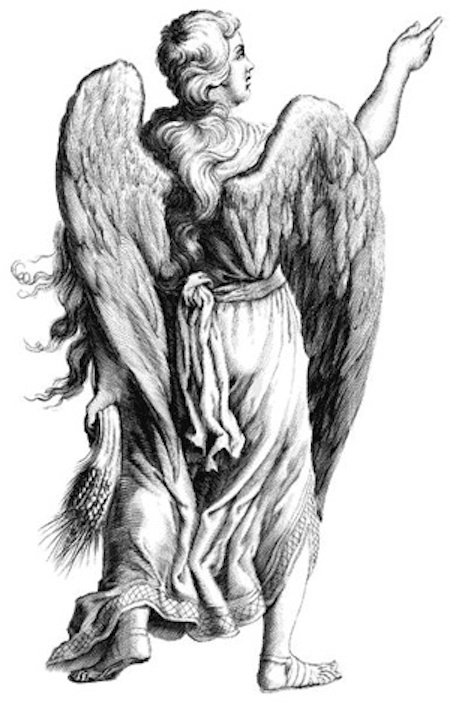
Virgo the winged harvest goddess. Image via Hubble Source.
Bottom line: The constellation Virgo the Maiden fully returns to sky at nightfall – with her feet planted on the eastern horizon – by late April or early May. This post has information about how to find the constellation Virgo, its brightest star, interesting things to see within its boundaries, and its mythology.
Source:
https://earthsky.org/astronomy-essentials/virgo-heres-your-constellation